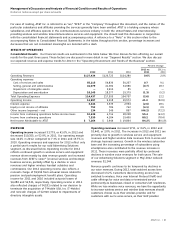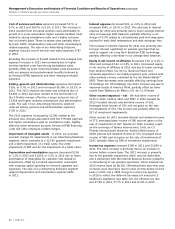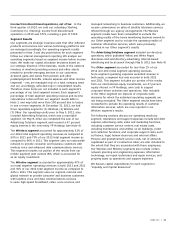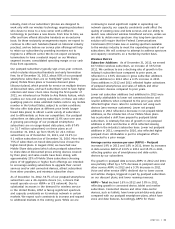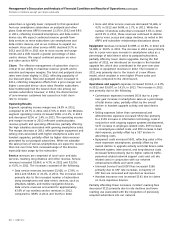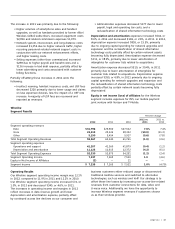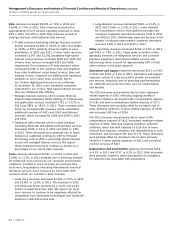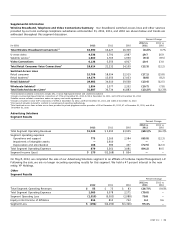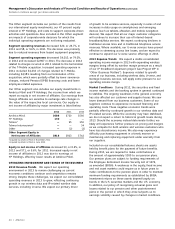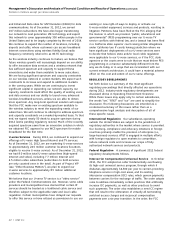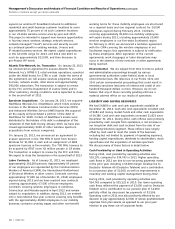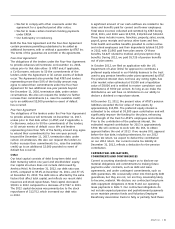AT&T Wireless 2012 Annual Report Download - page 43
Download and view the complete annual report
Please find page 43 of the 2012 AT&T Wireless annual report below. You can navigate through the pages in the report by either clicking on the pages listed below, or by using the keyword search tool below to find specific information within the annual report.
AT&T Inc. | 41
wireless data services requires the U.S. Government to make
more spectrum available. In February 2012, Congress
authorized the FCC to conduct an “incentive auction,” to
make available for wireless broadband use certain spectrum
that is currently used by broadcast television licensees.
The FCC has initiated a proceeding to establish rules that
would govern this process. It also initiated a separate
proceeding to review its policies governing mobile spectrum
holdings and consider whether there should be limits on the
amount of spectrum a wireless service provider may possess.
We seek to ensure that we have the opportunity, through
the incentive auction and otherwise, to obtain the spectrum
we need to provide our customers with high-quality service.
While wireless communications providers’ prices and service
offerings are generally not subject to state regulation, states
sometimes attempt to regulate or legislate various aspects of
wireless services, such as in the area of consumer protection.
Expected Growth Areas
We expect our wireless services and wireline IP-data products
to remain the most significant growth portions of our
business and have also discussed trends affecting the
segments in which we report results for these products (see
“Wireless Segment Results” and “Wireline Segment Results”).
Over the next few years, we expect our growth to come from:
(1) our wireless service and (2) data/broadband, through
existing and new services. We expect that our previous
acquisitions will enable us to strengthen the reach and
sophistication of our network facilities, increase our large-
business customer base and enhance the opportunity to
market wireless services to that customer base. Whether, or
the extent to which, growth in these areas will offset declines
in other areas of our business is not known.
Wireless Wireless is our fastest-growing revenue stream
and we expect to deliver continued revenue growth in
the coming years. We are in a period of rapid growth in
wireless data usage and believe that there are substantial
opportunities available for next-generation converged
services that combine wireless, broadband, voice and video.
For example, we are preparing to launch our innovative home
monitoring service (Digital Life), ISIS and other car-related
security and entertainment services.
We cover most major metropolitan areas of the United States
with our Universal Mobile Telecommunications System/
High-Speed Downlink Packet Access (HSPA) and HSPA+
network technology, with HSPA+ providing 4G speeds when
combined with our upgraded backhaul. At the end of 2012,
over 90 percent of our data traffic was carried over this
enhanced backhaul. Our network provides superior mobile
broadband speeds for data and video services, as well as
operating efficiencies using the same spectrum and
infrastructure for voice and data on an IP-based platform.
Our wireless network also relies on digital transmission
technologies known as GSM, General Packet Radio Services
Changes in our discount rate, which are tied to changes in
the bond market and changes in the performance of equity
markets, may have significant impacts on the fair value of
pension and other postretirement plans at the end of 2013
(see “Accounting Policies and Estimates”).
OPERATING ENVIRONMENT OVERVIEW
AT&T subsidiaries operating within the United States
are subject to federal and state regulatory authorities.
AT&T subsidiaries operating outside the United States
are subject to the jurisdiction of national and supranational
regulatory authorities in the markets where service is
provided, and regulation is generally limited to operational
licensing authority for the provision of services to
enterprise customers.
In the Telecommunications Act of 1996 (Telecom Act),
Congress established a national policy framework intended to
bring the benefits of competition and investment in advanced
telecommunications facilities and services to all Americans
by opening all telecommunications markets to competition
and reducing or eliminating regulatory burdens that harm
consumer welfare. However, since the Telecom Act was
passed, the FCC and some state regulatory commissions
have maintained or expanded certain regulatory requirements
that were imposed decades ago on our traditional wireline
subsidiaries when they operated as legal monopolies.
We are pursuing, at both the state and federal levels,
additional legislative and regulatory measures to reduce
regulatory burdens that are no longer appropriate in a
competitive telecommunications market and that inhibit our
ability to compete more effectively and offer services wanted
and needed by our customers, including initiatives to
transition services from traditional networks to all IP-based
networks. At the same time, we also seek to ensure that
legacy regulations are not extended to broadband or
wireless services, which are subject to vigorous competition.
In addition, states representing a majority of our local service
access lines have adopted legislation that enables new video
entrants to acquire a single statewide or state-approved
franchise (as opposed to the need to acquire hundreds or
even thousands of municipal-approved franchises) to offer
competitive video services. We also are supporting efforts to
update and improve regulatory treatment for retail services.
Regulatory reform and passage of legislation is uncertain
and depends on many factors.
We provide wireless services in robustly competitive markets,
but those services are subject to substantial and increasing
governmental regulation. Wireless communications providers
must obtain licenses from the FCC to provide communications
services at specified spectrum frequencies within specified
geographic areas and must comply with the FCC rules and
policies governing the use of the spectrum. The FCC has
recognized that the explosive growth of bandwidth-intensive


